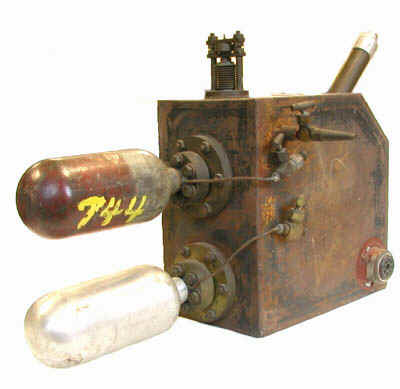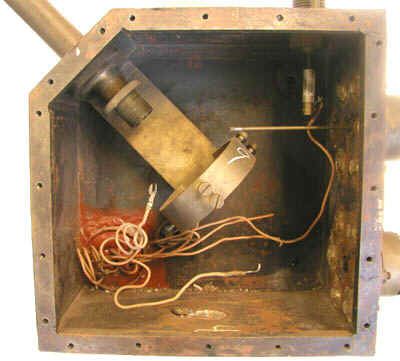Chang and Eng Neutron Detector (1940s)


In his interview for the BRH-sponsored video series Vignettes of Early Radiation Workers, Herb Parker stated that the "Chang and Eng is one of the more sensibly named of our foolishly named instruments." He went on to explain that he named it after the famous Siamese Twins because of the twin ionization chambers connected in parallel. He also stated that the "Ch" in Chang is a reference to the organic gas used to fill one of the chambers. The instrument's purpose was to measure fast neutrons in the presence of gamma rays, the type of environment found around a reactor.
In the standard Chang and Eng detector of the 1940s, one chamber was filled with argon at approximately 30 psi while the other chamber (lined with hydrogenous material) was filled with butane at 20 psi. Initially the detector was placed in a gamma field and the pressures in the chambers adjusted so that their ionization currents were equal. When subsequently placed in a mixed gamma-neutron field, both chambers would respond identically to the gamma rays but the chamber with the hydrogenous lining would also respond to the fast (high energy) neutrons.
A Lindemann electrometer was used to measure the difference in the currents from the two chambers which indicated the net neutron response. This measurement was converted into “reps” (roentgen equivalent physical).
This instrument is a bit of a mystery. It came from Oak Ridge National Laboratory where it was affixed with a tag that read "Historical Instrument, save for K.Z. Morgan." (it also has an ORNL property tag on it). Unfortunately, when I described this instrument to Dr. Morgan over the phone, he had absolutely no recollection of it. The lower of the two chambers, the one made from aluminum, is non-functional. It is a solid piece of aluminum with no chamber or collecting anode. I can only conclude that it was produced for aesthetic reasons, i.e., to replace a missing chamber. The microscope, which would fit into the brass tube projecting towards the upper left in the photograph to the left, is missing. Also missing is the electrometer that would be positioned in the center of the instrument and held in place by brass screws.
It is possible, but by no means certain, that this is the earliest Chang and Eng neutron detector in existence.
The following account is taken from a 1995 interview of K.Z. Morgan. The individuals he refers to, Carl Gamertsfelder and Herb Parker, were part of the original group of Health Physicists formed at the University of Chicago Metallurgical Laboratory in 1942 and 1943. Sometime in 1943, all three moved to the Clinton Laboratories in Oak Ridge. Within a year or so, Parker and Gamertsfelder had moved on to Hanford.
"Dr. Gamertsfelder and I, along with some help from Parker, developed what we called a "chang and eng." [This instrument consisted of] two small cylinders; one was filled with nonhydrogenous gas, like argon, and the other with gas like hydrogen or methane [CH4]. As you know, neutrons don't produce ionization along their path because they have no charge, and their only ability to cause ionization is when they strike one of the nuclear components—that is, a proton or a neutron or a collection of nuclear particles.
So, with two chambers—one filled with gas containing hydrogen, the other with no hydrogen—and having them under pressure to give a large cross-section, we measured the differential output of these two chambers. I could measure [accurately] the neutron contribution from fast neutrons. Now, these chambers were very effective and very quantitative in their evaluation, so I used them later in some experiments in Oak Ridge."
Donated by Oak Ridge National Laboratory.
References
- Human Radiation Studies: Remembering the Early Years. Oral History of Health Physicist Karl Z. Morgan, Ph.D. Conducted January 7, 1995 United States Department of Energy Office of Human Radiation Experiments June 1995.
- Davis, DM. Health Physics Division Instrument Manual. ORNL 332. 1949.
